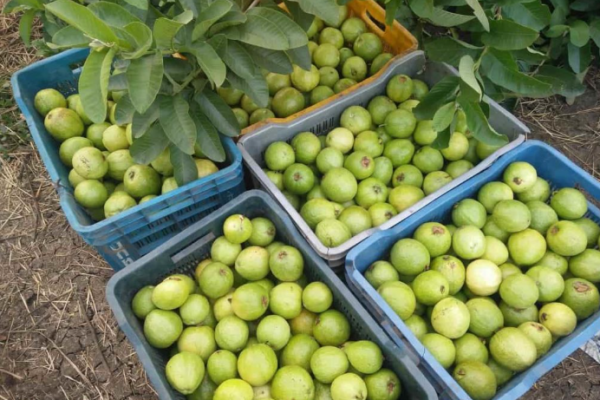16 Common Guava Tree/Plant Problems: How to Fix Them, Solutions, and Treatment
16 Common Guava Tree/Plant Problems: How to Fix Them, Solutions, and Treatment

Guava trees are amazing specimens in your garden or backyard to give you a tropical flavor. Like any fruit tree, Guavas have a big payoff but a big investment, which can be disappointing or scary when something seems wrong. Guava may be hardy, but they have part of the problems of Guava pests, most of which can be tackled for Guava trees using natural pest control methods.
Common Guava tree/plant problems
The Guava tree won’t bear fruit
Guava plants need full sun and shade to grow, but they can’t withstand too much heat. They dislike too cold and are very soft to frost. Also, Guava will not bear fruit, whether grown from seed or grafting, until its third year.
Solution – Choose a place to shelter from cool winds or frost and full sun to partial. Spread a 3 to 4-inch layer of organic mulch around the tree’s base to help maintain moisture, suppress weeds, and nurture roots. Be careful with the tree’s shallow root system if weeds are removed from the garden appliances.
Make sure to provide proper water to the tree. On planting and for the first month, water daily. You can reduce the water by once a week once the tree is established; the water at the tree’s base. Water the tree after fertilization to help carry nutrients through plant roots and prevent nitrogen burns.
Guava leaves are turning brown
Anthracnose
There may be many more problems than anthracnose, but this could also be why Guava leaves turn brown. The disease is affecting a lot of trees and plants.
Solution – Applying fungicides will help in getting rid of anthracnose. The tree will start recovering when the disease is over. The choice of Guava trees resistant to anthracnose is great. The tree will grow well, and more flowers and fruits will grow.
Salt on soil
Having salt on the soil can make the leaves brown on the Guava tree. Salt can be formed on the ground if you feed your tree with chemicals like fertilizer.
Solution – The best thing is to give water. The water will dissolve the salt, and the tree will recover after a few days or weeks.
Dehydration
Dehydration can also be the reason for the browning of leaves on the Guava tree. This is because the tree does not have enough water supply, and the leaves will be affected. They need plenty of water regularly to maintain their good condition. You can use some great tools to water the Guava tree.
Sometimes the weather is so hot, especially during the summer. During this period, the tree needs a lot of water to stay fresh and cool. Water will help leaves to keep flourishing green and well. Water will also help flowers and fruits grow, and the tree will survive and prevent leaves from turning brown.
Solution – If you see that many leaves are turning brown on your Guava tree, giving them plenty of water can help. You will see improvement after a few days.
Too much water
Too much water can cause leaves to wilt and yellow, but it can also cause leaves to brown. This will be the effect of more water. Sometimes there are storms or heavy rains, and the tree is under the flood. The flood gives too much water to the tree, and they can’t handle too much water. This will result in more yellow and brown leaves. It will keep the tree in bad condition.
Solution – A good drainage system will help prevent the tree from flooding.
Too much sunlight
The Guava tree grows well in tropical and subtropical countries. They love sunlight more than it helps them grow. But sometimes it happens that too much sunlight can burn their leaves. Since sunlight is hot, it can damage these parts. This can happen when the weather is very hot, especially in summer.
Solution – If the tree is of dwarf varieties, it is great to grow indoors in the pot and keep it under the shade when the weather is very hot.
Transplant shock
Transplants can shock the plant, which causes the leaves to brown and wilt. It’s really important that during transplants, you must be careful in catching the seedlings so that it doesn’t move so much.
Solution – The soil should remain compact, and gradually remove the seedlings from the pot. Then carefully move it to the ground. The hole on the ground on the root ball should be a little bigger. Making it bigger will provide enough space for roots to grow and expand. Putting some soil on the roots and applying water will help establish the roots.
The Guava tree won’t bloom
Age of plants
Fruit plants need many years to mature, whereas Guava waits three to four years from planting its first crop.
Solution – If your plant is smaller than that, or you don’t know when it was planted, and it looks otherwise healthy, it’s very safe to assume it’s too small to flower.
Excessive water
Excessive water can affect leaf drops, stem death, and even the death of trees, all the things that will interfere with the blooming and increase the stress on the plant.
Solution – Keep your Guavas on the dry side.
Sun exposure
Guava living well indoors can refuse to bloom because they lack a vital ingredient that requires all the blooming Guavas: ultraviolet light. Guavas like a lot of bright, direct sunlight, but if your plant is indoors, don’t move it into the window or leave it out simultaneously.
Solution – Place it in bright conditions first, leave it in a shady outdoor space, for a few hours in the sun, and, eventually, work full time in the sun.
Root binding
Guava is a diverse group that grows in different sizes and shapes. Some are well suited to large pots, but many are not in the ground and should be planted.
Solution – Guavas form huge, broad root systems and bloom more easily when they can spread out of their canopies.
Nutrient deficiency
Nitrogen – Stunted growth with pale green to light yellow (chlorosis) appears first on old leaves, usually starting on tips. Depending on the severity of the deficiency, chlorosis can result in death and the dropping of old leaves.
Solution – You should apply 1 to 2% urea foliar spray at fortnightly intervals.
Phosphorus – Slow, weak, and stunted growth with dark to blue-green appearing on some plants’ old leaves. Purpling can appear in leaves and stem under severe deficiency. Late maturity and poor seed and fruit growth.
Solution – You should apply 2% DAP foliar spray at the fortnightly interval.
Potassium – Chlorosis along the edges of leaves is first among the old leaves. The growth of plants lacking in potassium will slow and stunt growth. The size of seeds and fruits and their production decreases.
Solution – You should apply 2% K2SO4 foliar spray at fortnightly intervals.
Calcium – Symptoms first appear on small leaves and leaf tips. New emerging leaves can stick together on the margins, causing leaves to expand and unfurl. Small leaves can be crinkled, with terminal buds getting damaged.
Solution – You can add 100 kg of Gypsum to the soil.
Magnesium – The symptom of lack of interveinal chlorosis is first reflected in the old leaves. Leaf tissue between veins can be yellow, bronze, or reddish, while leaf veins remain green. In severe cases, symptoms can appear at younger addresses and cause premature leaf drop. Symptoms are frequent in acid soil and soil with high amounts of potassium and calcium.
Solution – You can apply 2% of MgSO4 foliar spray at the fortnightly interval.
Sulfur – Small leaves are chlorotic with uniform, light-colored veins. The growth rate decreases and maturity are delayed. Symptoms can be similar to a lack of nitrogen and are often found in sandy soils with low organic matter intake and moderate to heavy rainfall.
Solution – You can add 100 kg of Gypsum to the soil.
Boron – Stunted growth, first appearing signs on the growing point, and small leaves. Leaves thicken and can turn bitter and become brittle.
Solution – You should add 0.5% of Borax foliar spray at the fortnightly interval.
Guava leaves turn yellow
Guava trees can’t withstand temperatures below freezing, so gardeners in most zones must bring them in for cold months. This is the most desirable reason for yellow leaves on the Guava tree, a combination of different light, water, and moisture. This is especially common for this yellow in spring when the tree has spent the most time indoors.
Generally, yellowing will start at the lowest leaves and work its way. Fortunately, Guava trees are very flexible. If your tree appears to be yellowing in winter, the best thing to do is wait for the hot weather. Once it’s back out, it should take advantage. Not all yellow leaves on the Guava tree are due to too cold.
If your tree is out in the heat, there are many other possible reasons. Most plants will turn yellow to signify the stress if the weather is unusually hot or cold and wet or dry; it can be guilty. There is also a possibility that yellow leaves are a symbol of nematodes. Many nematodes are attacking the roots of the Guava tree.
Solution – To discourage nematode attack, mulch your Guava trees and pay special attention to fertilizer and water. And always avoid planting where there is a known nematode attack.
Guava leaves curling
Dehydration
The first reason why Guavas have leaves curling is the lack of water. When the Guava tree gets underwater, it can suffer the leaves being curled. This can sometimes happen when the farmer does not give enough water to the tree or during a prolonged drought. Dehydration can cause stress on the tree.
Solution – When you give enough water to your Guava tree, there will be more flowers, healthy leaves, and lots of fruit. During summer, they need water almost daily as it quickly evaporates. Good water is essential for the tree to flourish well.
Root damage
Damage to roots can occur when there is a lot of water on the ground, causes root rot, or disease damages the roots of the Guava tree.
Solution – You need to think about possible events that can cause root rot on the Guava tree and create a great solution to prevent it from happening. When the roots remain healthy, there will be no damage, leaves will not curl, and more fruits will come soon. Large Guavas will grow on the tree.
Lack of sunlight
Lack of sunlight can also cause curly leaves. The Guava tree should regularly get enough sunlight to prepare its food. When the sun is not enough, they cannot make enough food to grow. This can also make the leaves curl.
Solution – When the tree is planted near other large trees, they may block sunlight. The best thing is to find a good place where no large trees are nearby before planting the Guava tree.
Transplant shock
If the tree experiences a transplant shock, some leaves may fall, yellow, or curl.
Solution -You can give little water. Do not apply any fertilizer yet and observe the tree day by day. The tree may return to normal after a few days.
Overfertilization
Another reason why Guava leaves curl is more fertilization. Fertilizers made by chemicals become harmful when applied too much. You must ensure that the fertilizer you put in your Guava tree is correct. This way, there will be more prevention than fertilization.
Solution – You should only use organic fertilizers. They are eco-friendly because they do not contain several chemicals. Organic fertilizers are made of organic matter like leaves, grass, wood chips, etc.
Pests and diseases
Sometimes, pests and diseases can also cause Guava leaves to be curled. You need to monitor your tree to determine if some pests and diseases attack the tree. This way, you can protect the entire tree and prevent any damage from being caused.
Solution – If pests attack the tree, you can apply pesticides or insecticides, while if there are diseases, you can use fungicides.
Pests
Black scale
Black scale affects the productivity of Guava trees.
Solution – This soft-bodied pest is intolerant to dry conditions. Cutting selected branches from the tree canopy increases airflow, and more sunlight reaches the lower leaves. It creates dry conditions and controls black-scale populations.
Ant
Ants not only protect the scale from predators, but they help to move these pests around the plant, which increases the effect of infections.
Solution – You can control ants naturally. Start by cutting down branches touching buildings or other plants, which act as a tree bridge. Then, wrap the sticky tape, which is designed to prevent tree pests from climbing the tree around the stem. Either as an extra or lonely measure, take out the traps baited with sugar water and boric acid.
White fly
Whitefly is the minor pest of Guava trees and usually does not require treatment to control its population.
Solution -To control naturally white flies, get rid of the affected leaves and spray on the tree with your garden’s hose, spray setting to knock the tree down from the tree. No available chemical pesticides do an excellent job of controlling white flies. Pesticides kill natural predators and can increase the white fly population rather than decrease it.
Root-knot nematodes
Root-knot nematodes do not directly damage the fruit of Guava. However, Guava trees planted in sandy soil are sensitive to these pests and can cause severe damage that affects fruit production. Symptoms of root-knot nematode attack include wilt and yellowing of leaves even after watering and production of less than normal and small fruits and leaves.
Solution – Root-knot nematodes rarely kill trees but are difficult to control once established. Provide excellent growth conditions, including proper irrigation, drainage, and fertilizers to increase plant enthusiasm and help trees fight and reduce damage.
Diseases
Wilt
The plant can produce light yellow leaves and bend, shed premature fruit, or be completely defoliated.
Solution – There is no cure for wilt infections in plants. Still, good nutrition, including heavy doses of nitrogen after fruiting, and protecting the roots from damage can help prevent the disease.
Stylar end rot
After only affecting fruits, this problem often comes to the surface once the fruit is grown. You will see that the blooming end of the fruit discolors, and the area spreads until the fruit turns brown to black and very soft.
Solution – Once the fruit is affected, it is not safe, but you can protect the rest of your crop by using fungicides spray. After fruiting, picking up fallen debris, thinning your Guavas, and moving further away from the plants can help prevent re-infection.
Anthracnose
Anthracnose is a common fungus problem for many plant species, including Guavas. You can see young shoots die back dramatically with fruit and leaves, or fruits and leaves produce small black dots that quickly grow into dark brown, simmers wounds.
Solution – If your bush is large or has not been produced in a while, find anthracnose-resistant types for better success.
Algal leaf spot
If you see rusted or brown spots that emerge during humid weather, it can be a variety of parasitic algae affecting your Guava. While the algal leaf spot is relatively harmless to both plants and fruits, severe infection can reduce excitement, reducing the energy the plant puts into developing fruits.
Solution – The best treatment is to do everything you can to reduce moisture around your plant, including pruning it and nearby plants to allow better airflow to all parts of the canopy.
Guava rust
Rust disease can be very devastating to Guava-producing areas around the world. Specific symptoms associated with the disease include disinfection, defoliation, low growth, and death if severe.
Solution – Control of Guava rust is based on the use of fungicides. It is recommended to look for trees for the onset of disease or during the time of year when environmental conditions are conducive to pathogen infection so that appropriate and timely fungicides can be applied. Also, appropriate cultural tactics such as proper fertilization, irrigation, harvesting, and sanitation support achieving a healthy, vigorously growing tree less prone to disease stress.
Powdery mildew
Powdery mildew is the easiest to identify, as these symptoms are quite distinctive.
Solution – Effective organic fungicides to treat powdery mildew include sulfur, lime sulfur, neem oil, potassium bicarbonate, and baking soda. You should use these fungicides before infection or when you see symptoms of the disease for the first time.
Conclusion
You can face all these problems when you are growing a Guava tree. Some reasons are to detect easily, but some are difficult. It is best to know the root of the problem by applying the best solution as soon as possible. The tree will continue to grow when the problem is fixed. Urgent treatment is needed to prevent some of the problems. Analyzing the tree and finding out what the cause is to be done first, and then there is the solution.
Posted
3 years ago
No comments yet! Why don't you be the first?










Add a comment